
The Louisiana Purchase was the acquisition of the territory of Louisiana by the United States from the French First Republic in 1803. This consisted of most of the land in the Mississippi River's drainage basin west of the river. In return for fifteen million dollars, or approximately eighteen dollars per square mile, the United States nominally acquired a total of 828,000 sq mi in Middle America. However, France only controlled a small fraction of this area, most of which was inhabited by Native Americans; effectively, for the majority of the area, the United States bought the preemptive right to obtain Indian lands by treaty or by conquest, to the exclusion of other colonial powers.

The French Quarter, also known as the Vieux Carré, is the oldest neighborhood in the city of New Orleans. After New Orleans was founded in 1718 by Jean-Baptiste Le Moyne de Bienville, the city developed around the Vieux Carré, a central square. The district is more commonly called the French Quarter today, or simply "The Quarter", related to changes in the city with American immigration after the 1803 Louisiana Purchase. Most of the extant historic buildings were constructed either in the late 18th century, during the city's period of Spanish rule, or were built during the first half of the 19th century, after U.S. purchase and statehood.

St. Augustine is a city in and the county seat of St. Johns County located 40 miles south of downtown Jacksonville. The city is on the Atlantic coast of northeastern Florida. Founded in 1565 by Spanish explorers, it is the oldest continuously inhabited European-established settlement in what is now the contiguous United States.
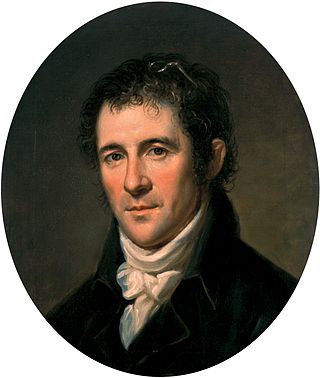
Benjamin Henry Boneval Latrobe was an Anglo-American neoclassical architect who immigrated to the United States. He was one of the first formally trained, professional architects in the new United States, drawing on influences from his travels in Italy, as well as British and French Neoclassical architects such as Claude Nicolas Ledoux. In his thirties, he immigrated to the new United States and designed the United States Capitol, on "Capitol Hill" in Washington, D.C., as well as the Old Baltimore Cathedral or The Baltimore Basilica,. It is the first Cathedral constructed in the United States for any Christian denomination. Latrobe also designed the largest structure in America at the time, the "Merchants' Exchange" in Baltimore. With extensive balconied atriums through the wings and a large central rotunda under a low dome which dominated the city, it was completed in 1820 after five years of work and endured into the early twentieth century.

The Spanish Colonial Revival style is an architectural stylistic movement arising in the early 20th century based on the Spanish colonial architecture of the Spanish colonization of the Americas.
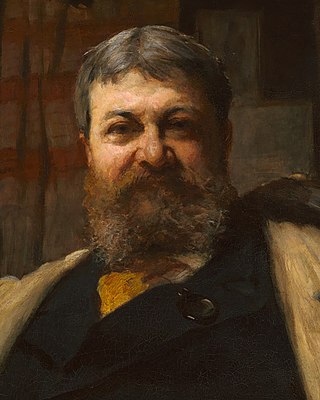
Henry Hobson Richardson, FAIA was an American architect, best known for his work in a style that became known as Richardsonian Romanesque. Along with Louis Sullivan and Frank Lloyd Wright, Richardson is one of "the recognized trinity of American architecture".

Egyptian Revival is an architectural style that uses the motifs and imagery of ancient Egypt. It is attributed generally to the public awareness of ancient Egyptian monuments generated by Napoleon's conquest of Egypt and Admiral Nelson's defeat of the French Navy at the Battle of the Nile in 1798. Napoleon took a scientific expedition with him to Egypt. Publication of the expedition's work, the Description de l'Égypte, began in 1809 and was published as a series through 1826. The size and monumentality of the façades discovered during his adventure cemented the hold of Egyptian aesthetics on the Parisian elite. However, works of art and architecture in the Egyptian style had been made or built occasionally on the European continent since the time of the Renaissance.

Bernardo Vicente de Gálvez y Madrid, 1st Count of Gálvez was a Spanish military leader and government official who served as colonial governor of Spanish Louisiana and Cuba, and later as Viceroy of New Spain.
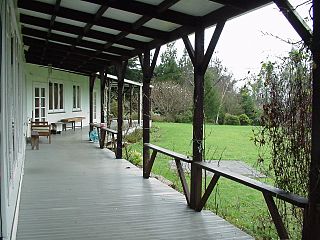
A veranda or verandah is a roofed, open-air hallway or porch, attached to the outside of a building. A veranda is often partly enclosed by a railing and frequently extends across the front and sides of the structure.

The history of New Orleans, Louisiana traces the city's development from its founding by the French in 1718 through its period of Spanish control, then briefly back to French rule before being acquired by the United States in the Louisiana Purchase in 1803. During the War of 1812, the last major battle was the Battle of New Orleans in 1815. Throughout the 19th century, New Orleans was the largest port in the Southern United States, exporting most of the nation's cotton output and other farm products to Western Europe and New England. As the largest city in the South at the start of the Civil War (1861–1865), it was an early target for capture by Union forces. With its rich and unique cultural and architectural heritage, New Orleans remains a major destination for live music, tourism, conventions, and sporting events and annual Mardi Gras celebrations. After the significant destruction and loss of life resulting from Hurricane Katrina in 2005, the city would bounce back and rebuild in the ensuing years.
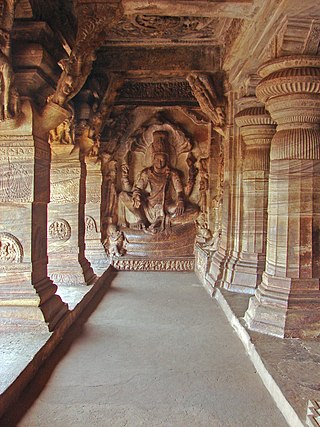
The Badami cave temples are a complex of Hindu and Jain cave temples located in Badami, a town in the Bagalkot district in northern part of Karnataka, India. The caves are important examples of Indian rock-cut architecture, especially Badami Chalukya architecture, and the earliest date from the 6th century. Badami is a modern name and was previously known as "Vataapi", the capital of the early Chalukya dynasty, which ruled much of Karnataka from the 6th to the 8th century. Badami is situated on the west bank of a man-made lake ringed by an earthen wall with stone steps; it is surrounded on the north and south by forts built during Early Chalukya and in later times.

James Gallier was a prominent nineteenth-century Irish-born American architect, most famed for his buildings in New Orleans. Gallier Hall, which he designed and once served as New Orleans City Hall, is named after him.

George Michael Decker Hahn, was an attorney, politician, publisher and planter in New Orleans, Louisiana. He served twice in Congress during two widely separated periods, elected first as a Unionist Democratic Congressman in 1862, as a Republican to the U.S. Senate in 1865, and later as a Republican to the U.S. House of Representatives in 1884. He was elected as the 19th Governor of Louisiana, serving from 1864 to 1865 during the American Civil War, when the state was occupied by Union troops. He was the first German-born governor in the United States, and is also claimed as the first ethnic Jewish governor. By that time he was a practicing Episcopalian.
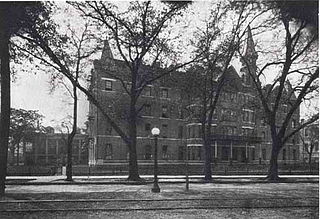
New Orleans University was a historically black college that operated between 1869 and 1935 in New Orleans, Louisiana, United States. It was founded by Freedmen's Aid Society and the Methodist Episcopal Church. It merged with Straight College in 1935 to form Dillard University.

The Piedmont Hotel was a hotel in Downtown Atlanta, Georgia, United States. Construction on the building, which was designed by architect Willis F. Denny, began in 1901, and the building was opened to the public in January 1903. Considered one of the finest hotels in the city at the time, numerous famous guests stayed at the hotel while visiting Atlanta, including three presidents of the United States. Unlike other Atlanta hotels, the Piedmont sought to emulate the style of hotels in the northeastern United States and was commonly referred to by locals as "our New York City hotel". In 1929, the building went through an extensive renovation overseen by the architectural firm of Pringle & Smith. In 1965, the owners of the hotel agreed to sell the property to the Equitable Life Assurance Society of the United States, who planned to build a new office building on the site. The hotel was demolished that year and in 1968, the Equitable Building was completed.
The following is a timeline of the history of the city of New Orleans, Louisiana, USA.
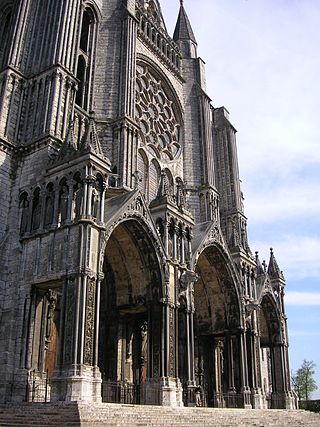
A porch is a room or gallery located in front of an entrance of a building. A porch is placed in front of the façade of a building it commands, and forms a low front. Alternatively, it may be a vestibule, or a projecting building that houses the entrance door of a building.

Founded in the 1830s as a railroad terminus, Atlanta experienced rapid growth in its early years to become a major economic center of Georgia, with several hotels built to accommodate for this growth. Following its destruction during the Civil War, Atlanta experienced a resurgence and another hotel boom commenced in the late 1800s through the early 1900s. In the later half of the 20th century, hotel skyscrapers began to appear on the skyline, including what was at the time the tallest hotel in the United States. Later, a trend emerged of converting old office buildings into boutique hotels.
Sonesta International Hotels Corporation is an American hotel company founded in 1937, and based in Newton, Massachusetts. Sonesta's largest hotels are in Los Angeles, Houston, Chicago and New Orleans. Its brands include The Royal Sonesta, The James Hotels, Classico—A Sonesta Collection, Sonesta Hotels & Resorts, MOD—A Sonesta Collection, Sonesta Select, Sonesta Essential, Sonesta ES Suites, Sonesta Simply Suites, Sonesta Cruise Collection, Sonesta Posadas del Inca, Red Lion Hotels, Red Lion Inn & Suites, Signature Inn, GuestHouse Extended Stay, Americas Best Value Inn, Canadas Best Value Inn and Knights Inn. It is the eighth largest hotel company in the United States.

Banks' Arcade was a multi-use commercial structure in New Orleans, Louisiana, United States. The building on the block bounded by Gravier Street, Tchoupitoulas Street, Natchez Street, and Magazine Street, in the district then known as Faubourg Sainte Marie, later known as the American sector and now called the Central Business District. The building's central axis, originally called Banks' Alley or the Arcade Passage, is now a walk street called Arcade Place within Picayune Place Historic District.


















